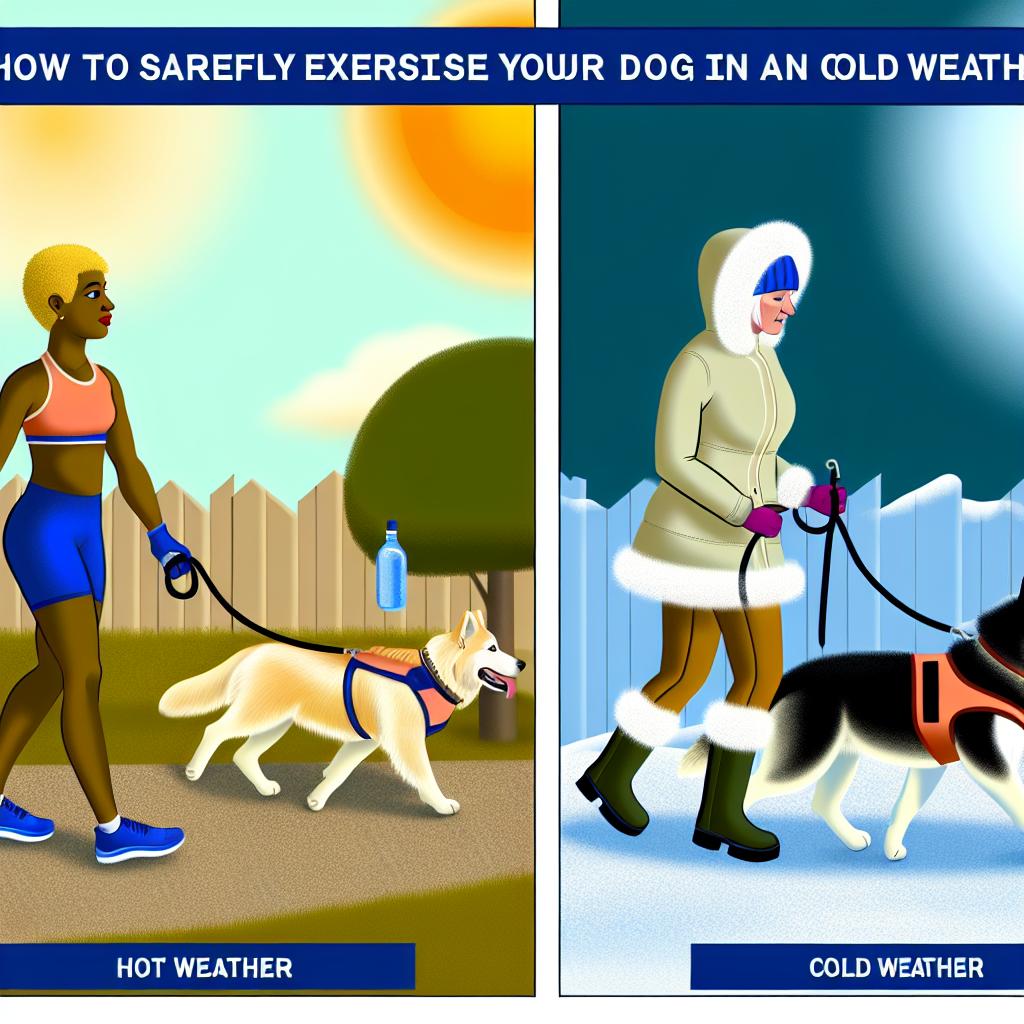
Ensuring your dog gets ample exercise is crucial for their physical and mental well-being. Regular physical activity promotes cardiovascular health, maintains a healthy weight, and provides mental stimulation for your furry companion. However, varying weather conditions can pose challenges. Both hot and cold weather have unique risks that need to be addressed for safe exercise sessions. As a pet owner, it is essential to adapt to these environmental changes to keep your dog safe and comfortable.
Ensuring your pet remains comfortable and healthy during hotter months requires thoughtful strategies and proactive measures.
Hydration: Maintaining hydration is critical during warm days as dogs can quickly become dehydrated, which can lead to serious health issues. Always carry a sufficient amount of water and ensure your dog drinks at regular intervals. It may be helpful to bring a collapsible bowl or portable water bottle specifically designed for pets, allowing you to offer your dog water conveniently during your walks.
Time of Day: Timing your exercise sessions wisely can make a significant difference. Opt for early morning or late evening sessions when temperatures are lower. This reduces the risk of heat exhaustion because these times of day typically offer cooler temperatures and more pleasant conditions for your dog. Avoid outdoor activities during midday when the sun is at its peak and the heat is strongest.
Paw Safety: Hot pavement can burn your dog’s paws, leading to painful injuries. Before starting your walk, test the pavement with your hand. If it’s too hot for you, it’s too hot for your dog. If walking distances are unavoidable, you may consider dog booties to protect their paws from burning surfaces.
Shaded Areas: Seek out shaded spaces for your exercise routines. Exercising in shaded areas allows your dog to cool down more effectively and provides a reprieve from direct sunlight. Parks with abundant trees or designated shaded areas along trails can be ideal locations for exercising your dog in hot weather.
Signs of Overheating: It’s essential to be vigilant for signs of heatstroke, which include excessive panting, drooling, or a rapid heartbeat. If you notice these signs, it’s critical to cease all activities immediately and cool your dog down by offering water and getting them to a shaded or air-conditioned area. More detailed information on preventing heat-related issues can be found here.
Maintaining your dog’s exercise routine during colder months is important for continued health but requires careful considerations to ensure their well-being.
Insulation: Dogs with thin coats may be more prone to feeling cold and may need an extra layer to maintain warmth during particularly cold days. A dog sweater or jacket can provide the necessary insulation to keep them warm and comfortable during outdoor activities.
Paw Care: Winter conditions present unique challenges for your dog’s paws. Salt and ice can damage your dog’s paws, causing irritation or injuries. Consider using dog booties for added protection. Alternatively, make a habit of cleaning their paws thoroughly after walks to remove any ice, salt, or debris.
Avoid Ice: Be cautious around frozen bodies of water. Thin ice can be deceptive and poses dangers for both the owner and the dog. Ensure any area you allow your dog to walk on is solid and safe.
Visibility: Shorter days and dim light conditions necessitate the use of reflective gear to ensure that both you and your dog are visible to others. Reflective collars, vests, or leashes enhance visibility during early morning or evening walks, reducing the risk of accidents.
Cold Weather Risks: Hypothermia and frostbite are real dangers for dogs in cold weather. For more information on mitigating cold weather risks for your dog, refer here. It’s crucial to monitor your dog for signs of discomfort, such as shivering or reluctance to continue walking, and take appropriate action to keep them warm.
The changing weather conditions require adjustments to ensure that your dog remains comfortable and enjoys their exercise routines all year round.
Know Your Dog: Each dog has different tolerance levels for various weather conditions. Factors like age, breed, and health status influence how a dog copes with different temperatures. Understanding your dog’s limits and adjusting activities accordingly ensures their safety and enjoyment.
Indoor Alternatives: When outdoor conditions are too extreme for safe exercise, consider engaging your dog in indoor activities. Interactive toys, puzzle games, or setting up indoor obstacle courses can provide mental stimulation and physical activity, even when confined at home.
Consult Your Veterinarian: Regular check-ups with your veterinarian ensure an appropriate exercise plan tailored to your dog’s specific needs. Your vet can provide valuable insights based on factors such as your dog’s health history, age, and breed, ensuring that the exercise they receive is beneficial and safe.
Safely exercising your dog in any weather involves planning and attention to detail. Each weather condition—whether hot, cold, or in between—presents its own set of challenges and necessitates specific considerations to prevent discomfort and health risks. By keeping your dog’s safety at the forefront and making informed decisions about exercise routines, you ensure their well-being and maintain a positive and healthy experience year-round. Prioritizing adequate exercise contributes to your dog’s overall health and enhances the bond between you and your pet, fostering a happy and fulfilling life together.